Search
- Page Path
-
- HOME
- Search
- Original Article
- Gastroenterology
- Association between maternal weight gain during pregnancy and child’s body mass index at preschool age
- Jeewon Shin, Yoowon Kwon, Ju Hee Kim, Su Jin Jeong
- Clin Exp Pediatr. 2023;66(2):76-81. Published online November 30, 2022
-

Question: What are the risk factors of newborn birth weight? Does gestational weight gain and prepregnancy body mass index affect childhood weight?
Finding: Excess maternal weight gain increases the risk of overweight/obesity, newborn birth weight, and child body mass index at 4–6 years.
Meaning: Maternal weight control before and during pregnancy should be well controlled.
- Neonatology (Perinatology)
- Mediation effect of cord blood cortisol levels between maternal prepregnancy body mass index and birth weight: a hospital-based cross-sectional study
- Nisanth Selvam, Jayashree K, Prasanna Mithra
- Clin Exp Pediatr. 2022;65(10):500-506. Published online July 29, 2022
-

Question: What is the association between cord blood cortisol and maternal weight, birth weight, and cord blood lipid profile?
Finding: Cord blood cortisol levels did not influence the relationship between maternal weight changes or birth weight. Maternal weight changes, birth weight, and cortisol levels altered the cord blood lipid profile.
Meaning: Our findings may aid United Nations Sustainable Development Goal 3 (Good Health and Well-Being) achievement by 2030.
- Developmental and Behavioral Medicine
- Effectiveness of obesity interventions among South Korean children and adolescents and importance of the type of intervention component: a meta-analysis
- Siyoung Choe, Jaesin Sa, Jean-Philippe Chaput, Deokjin Kim
- Clin Exp Pediatr. 2022;65(2):98-107. Published online November 23, 2021
-
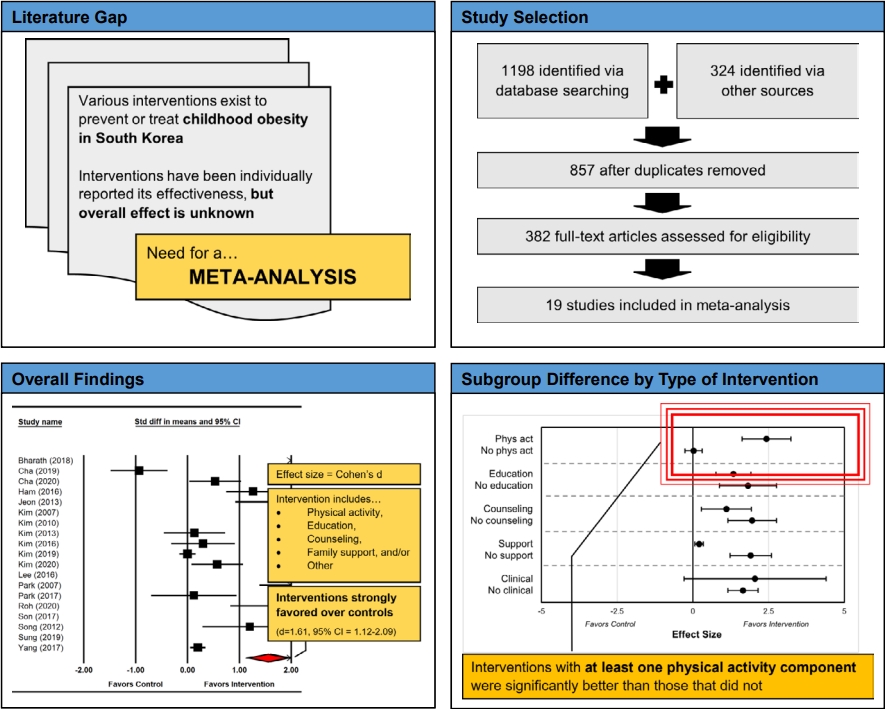
Question: What is the overall effect of obesity interventions among Korean children and what affects their effectiveness?
Finding: Interventions were strongly favored over controls. Interventions including at least one physical activity component were significantly better than those that did not. Sex, age, baseline weight category, intervention duration, and the number of intervention components were not significant.
Meaning: Future obesity interventions for Korean children must seek to include physical activity components.
- Systematic review and meta-analysis
- General Pediatrics
- The maternal prepregnancy body mass index and the risk of attention deficit hyperactivity disorder among children and adolescents: a systematic review and meta-analysis
- Ensiyeh Jenabi, Saied Bashirian, Salman Khazaei, Zohreh Basiri
- Clin Exp Pediatr. 2019;62(10):374-379. Published online June 14, 2019
-
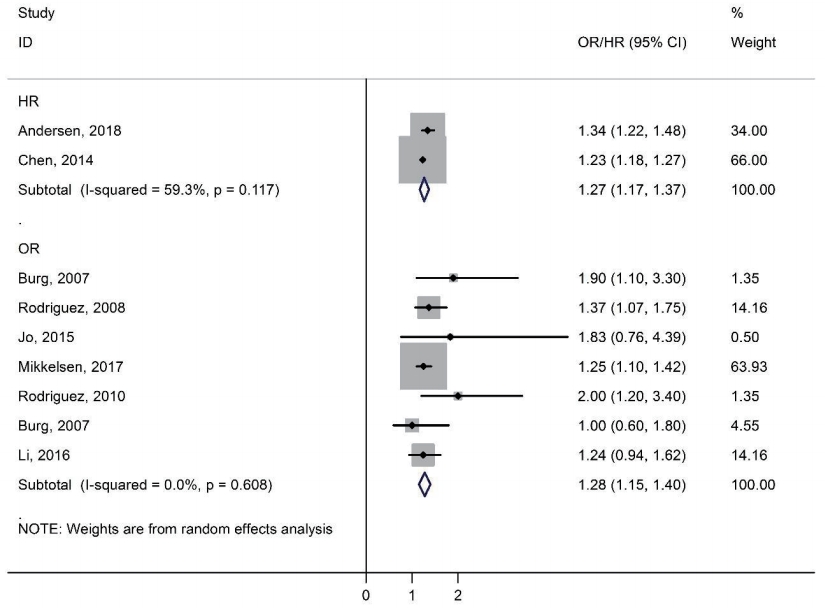
Background: Attention deficit hyperactivity disorder (ADHD) symptoms have a major impact on individuals, families, and society. Therefore identification risk factors of ADHD are a public health priority.
Purpose: This is meta-analysis evaluated the association between maternal prepregnancy body mass index and the risk of ADHD among the resulting offspring. Methods: The search identified studies published through December 2018 in the PubMed, Web...
- Review Article
- Endocrinology
- The adiposity rebound in the 21st century children: meaning for what?
- Min Jae Kang
- Clin Exp Pediatr. 2018;61(12):375-380. Published online December 6, 2018
-

With the increase in the prevalence of overweight and obesity worldwide, early adiposity rebound, which is known to have a strong association with obesity, has recently been a focus of research. Early adiposity rebound is conventionally known to have a close relationship with non-communicable diseases. However, novel insights into early adiposity rebound have implied an acceleration of growth and puberty,...
- Original Article
- Gastroenterology
- Nonalcoholic fatty liver disease in obese and nonobese pediatric patients
- Eun Jeong Kim, Hyun Jin Kim
- Clin Exp Pediatr. 2019;62(1):30-35. Published online September 17, 2018
-
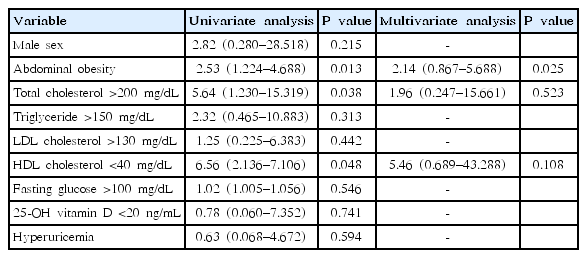
Purpose: Obesity is risk factor for nonalcoholic fatty liver disease (NAFLD). However, nonobese patients are also increasingly susceptible to NAFLD. The aim of this study was to compare the clinical characteristics of obese and nonobese pediatric patients with NAFLD. Methods: We retrospectively studied 68 patients who were diagnosed with NAFLD between January 2010 and October 2016 at 10–18 years of age....
- Developmental and Behavioral Medicine
- Mid-upper-arm circumference as a screening measure for identifying children with elevated body mass index: a study for Pakistan
- Muhammad Asif, Muhammad Aslam, Saima Altaf
- Clin Exp Pediatr. 2018;61(1):6-11. Published online January 22, 2018
-
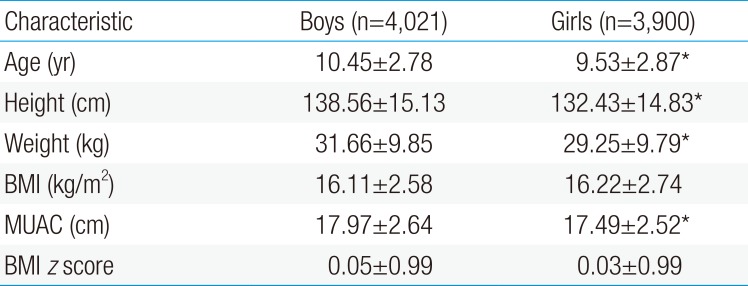
Purpose Mid-upper-arm circumference (MUAC) is considered an alternative screening method for obesity. The aims of this investigation were to examine the ability of MUAC to correctly identify children with elevated body mass index (BMI) and to determine the best MUAC cutoff point for identification of children with high BMI.
Methods Anthropometric measurements (height, weight, and MUAC) from a cross-sectional sample of 7,921 Pakistani...
- Endocrinology
- The influence of gonadotropin-releasing hormone agonists on anthropometric change in girls with central precocious puberty
- Jong Wan Yoon, Hyun A Park, Jieun Lee, Jae Hyun Kim
- Clin Exp Pediatr. 2017;60(12):395-402. Published online December 22, 2017
-
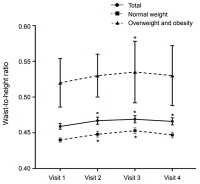
Purpose The potential effect of gonadotropin-releasing hormone agonist (GnRHa) treatment on the weight of girls with central precocious puberty (CPP) remains a controversy. We investigated anthropometric changes during and after GnRHa treatment among girls with CPP.
Methods This retrospective study evaluated data from 127 girls with CPP who received GnRHa treatment for ≥2 years. Height, weight, and body mass index (BMI) values were...
- Lipopolysaccharide-binding protein plasma levels as a biomarker of obesity-related insulin resistance in adolescents
- Ki Eun Kim, Young Sun Cho, Kyung Suk Baek, Lan Li, Kwang-Hyun Baek, Jung Hyun Kim, Ho-Seong Kim, Youn Ho Sheen
- Clin Exp Pediatr. 2016;59(5):231-238. Published online May 31, 2016
-
Purpose Lipopolysaccharide-binding protein (LBP) is a 65-kDa acute phase protein, derived from the liver, which is present in high concentrations in plasma. Data regarding the association between circulating plasma LBP levels and obesity-related biomarkers in the pediatric population are scarce. We aimed to determine whether there was a difference in plasma LBP levels between overweight/obese and normal-weight adolescents and to assess...
- Association between serum alanine aminotransferase level and obesity indices in Korean adolescents
- Moon Bae Ahn, Woo Ri Bae, Kyung Do Han, Won Kyoung Cho, Kyoung Soon Cho, So Hyun Park, Min Ho Jung, Byung Kyu Suh
- Clin Exp Pediatr. 2015;58(5):165-171. Published online May 22, 2015
-
Purpose To analyze the correlation between serum alanine aminotransferase (ALT) and obesity indices including body mass index (BMI), body fat percentage (BFP), total fat mass (FM), truncal fat mass (TFM), waist circumference (WC), and waist-to-height ratio (WHtR) in Korean adolescents.
Methods This was a cross-sectional study based on data derived from the 2010-2011 Korean National Health and Nutrition Examination Surveys (KNHANES). Subjects were...
- The association of blood pressure with body mass index and waist circumference in normal weight and overweight adolescents
- Young-Hwan Song
- Clin Exp Pediatr. 2014;57(2):79-84. Published online February 24, 2014
-
Purpose Overweight can be defined by the body mass index (BMI) and is likely associated with an increased cardiovascular disease risk. However, waist circumference (WC), a central adiposity index, may be a better indicator of cardiovascular disease risk. Studies comparing the effects of BMI and WC on cardiovascular risk factors, such as high blood pressure (BP), are rare in adolescents.
Methods We analyzed...
- The relationships of body mass index, waist-to-height ratio, and body fat percentage with blood pressure and its hemodynamic determinants in Korean adolescents: a school-based study
- Na Young Kim, Young Mi Hong, Jo Won Jung, Nam Su Kim, Chung Il Noh, Young-Hwan Song
- Clin Exp Pediatr. 2013;56(12):526-533. Published online December 20, 2013
-
Purpose Obesity is an important risk factor for hypertension in adolescents. We investigated the relationship of obesity-related indices (body mass index [BMI], waist-to-height ratio [WHR], and body fat percentage [%BF]) with blood pressure and the hemodynamic determinants of blood pressure in Korean adolescents.
Methods In 2008, 565 adolescents, aged 12-16 years, were examined. The %BF of the participants was measured by bioelectrical impedance...
- Diagnosis and constitutional and laboratory features of Korean girls referred for precocious puberty
- Doosoo Kim, Sung-Yoon Cho, Se-Hyun Maeng, Eun Sang Yi, Yu Jin Jung, Sung Won Park, Young Bae Sohn, Dong-Kyu Jin
- Clin Exp Pediatr. 2012;55(12):481-486. Published online December 20, 2012
-
Purpose Precocious puberty is defined as breast development before the age of 8 years in girls. The present study aimed to reveal the diagnosis of Korean girls referred for precocious puberty and to compare the constitutional and endocrinological features among diagnosis groups.
Methods The present study used a retrospective chart review of 988 Korean girls who had visited a pediatric endocrinology clinic from...
- Evaluation of changes in random blood glucose and body mass index during and after completion of chemotherapy in children with acute lymphoblastic leukemia
- Kyong-Won Bang, Soo Young Seo, Jae Wook Lee, Pil-Sang Jang, Min Ho Jung, Nack-Gyun Chung, Bin Cho, Dae-Chul Jeong, Byung Kyu Suh, Hack-Ki Kim
- Clin Exp Pediatr. 2012;55(4):121-127. Published online April 30, 2012
-
Purpose Improved survival of patients with childhood acute lymphoblastic leukemia (ALL) has drawn attention to the potential for late consequences of previous treatments among survivors, including metabolic syndrome. In this study, we evaluated changes in 3 parameters, namely, random blood glucose, body mass index (BMI), and Z score for BMI (Z-BMI), in children with ALL during chemotherapy and after completion of...
- Review Article
- Secular trends of body sizes in Korean children and adolescents: from 1965 to 2010
- Jin Soo Moon
- Clin Exp Pediatr. 2011;54(11):436-442. Published online November 30, 2011
-
An anthropometric survey is one of the most important approaches to use when evaluating the health status of children. Secular trends in body sizes, such as height, weight, head circumference, chest circumference, and body mass index showed significant changes over 40 years in Korea. A series of periodic surveys were conducted in 1967, 1975, 1985, 1997, and 2005 by the...
- Original Article
- The effectiveness of biochemical indexes for evaluating the nutrition states of children
- Jae Kwang Kim, Hyun Seong Jin, Myung Ki Han, Bong Seong Kim, Choong Hwan Cha, Kie Young Park
- Clin Exp Pediatr. 2009;52(2):167-175. Published online February 15, 2009
-
Purpose : This study has been conducted to analyze whether the biochemical nutrition indexes might be useful and effective for evaluating the nutrition states of children. Methods : We evaluated 269 children, aged 3-9 years old, who had visited Gangneung Asan Hospital for elective surgery from January 2006 to December 2007, and examined their anthropometric and preoperative laboratory data with... -
- Prevalence and trends in obesity among Korean children and adolescents in 1997 and 2005
- Kyungwon Oh, Myoung Jin Jang, Na Yeoun Lee, Jin Soo Moon, Chong Guk Lee, Myung Hwan Yoo, Young Taek Kim
- Clin Exp Pediatr. 2008;51(9):950-955. Published online September 15, 2008
-
Purpose : The objective of this study was to provide current estimates of the prevalence and examine trends of overweight and obesity in children and adolescents. Methods : Height and weight measurements from 183,159 (112,974 in 1997, 70,185 in 2005) children and adolescents aged 2 to 18 years were obtained via the 1997 and 2005 National Growth Survey. Obesity among... -
- The novel expression method of pediatric body composition : fat mass index and fat-free mass index
- Young Gyu Cho, Jae Heon Kang, Hye Ryoung Song, Kyung A Kim, Ji Hyun Song, Myeong Ho Jung
- Clin Exp Pediatr. 2007;50(7):629-635. Published online July 15, 2007
-
Purpose : This study was conducted to assess the usefulness of fat-free mass index (FFMI) and fat mass index (FMI) as novel expression methods of body composition in children. Methods : A total of 466 Second grade students-248 boys and 218 girls- from all elementary schools the Gwacheon City underwent anthropometric measures including bioelectrical impedance analysis (BIA) and biochemical tests. The... -
- Valproate-associated weight gain and potential predictors in children with epilepsy
- Gook Chan Jang, Eun Young Kim, Young Il Rho, Kyung Rye Moon, Sang Kee Park
- Clin Exp Pediatr. 2007;50(5):484-488. Published online May 15, 2007
-
Purpose : The purpose of this study was to determine the incidence and potential predictors of weight gain in older children and teens treated with valproate (VPA) for epilepsy. Methods : Sixty-five subjects aged 8 to 17 years of age, who began VPA treatment between January 1, 2001, and December 31, 2004, and who had documented weight and height measurements... -
- The iron status and the relationship between iron deficiency and body mass index in middle school girls
- Hee Youn Han, Chang Joo Hee, Hae Sun Shim, Young Jin Hong, Byong Kwan Son, Hwan Cheol Kim, Soon Ki Kim
- Clin Exp Pediatr. 2006;49(11):1174-1179. Published online November 15, 2006
-
Purpose : Obesity and iron deficiency are common nutritional problems. Obese children are known to have iron deficiencies, but one presented opposite opinion in Korea. This study investigated the prevalence of obesity and iron deficiency in Incheon and the relationship between iron deficiency and obesity. Methods : Physical measurement and hematologic examinations were done a 764 healthy female students aged 14... -
- Correlation of Body Mass Index, Body Fat Distribution, Aminotranferases and Computed Tomography in Obese Children with Fatty Liver
- So Eun Park, Hye Ran Yang, Ju Young Chang, Jae Sung Ko, Jeong Kee Seo, Whal Lee, Woo Sun Kim
- Clin Exp Pediatr. 2005;48(3):276-283. Published online March 15, 2005
-
Purpose : Visceral fat accumulation plays a major role in metabolic complications of obesity. It is known that nonalcoholic fatty liver in obese adults is associated with visceral fat accumulation. Body mass index(BMI) is used as the index of obesity in children. The aim of this study is to evaluate the correlation of BMI and visceral adipose tissue(VAT), and the... -
- Correlation between Percentage of Body Fat by BIA and Other Obesity Indices
- Su Jin Kim, Su Yung Kim
- Clin Exp Pediatr. 2004;47(5):491-495. Published online May 15, 2004
-
Purpose : Obesity is becoming a serious health problem in schoolage children and adolescents. There are several parameters to estimate obesity such as body mass index(BMI), skinfold thickness, obesity index and weight for height. Each parameter has some advantages and disadvantages. Bioelectrical impedance analysis(BIA) seems to be a simple, reproducible, objective and cost effective method for fat evaluation. But there... -
- Correlation of Measurements for Body Fat in Obese Children
- Jong Hoon Kim, In Seok Lim
- Clin Exp Pediatr. 2004;47(5):485-490. Published online May 15, 2004
-
Purpose : Measurement of body fat in obese children is useful not only in evaluating health hazard but also in establishing standards of treatment and evaluating the effectiveness of treatment. In the field of clinical and laboratory study, there are various methods with different reliability, propriety, convenience, and expenses. However, the practical value of these studies is limited in Korea,... -
- Trend of Obesity in School Age Children in Seoul Over the Past 23 Years
- Young Shin Park, Dong Hwan Lee, Joong-Myung Choi, Yun Ju Kang, Chong Hee Kim
- Clin Exp Pediatr. 2004;47(3):247-257. Published online March 15, 2004
-
Purpose : The aim of this study was to evaluate the change in prevalence and the epidemiology of obesity in school age children of Seoul, Korea during the last 23 years with coherency and under the same standards. Methods : We used the new 1998 standard weight for height to calculate obesity on the personal data from five years and produced... -
- A Study of the Relationship between Childhood Obesity and Beverage Intake
- Ji Hyun Oh, In Keun Kwak, Seung Yang, Il Tae Hwang, Ji Ah Jung, Hae Ran Lee
- Clin Exp Pediatr. 2003;46(11):1061-1066. Published online November 15, 2003
-
Purpose : The rising prevalence of childhood obesity may be due to an energy imbalance between food intake and energy expenditure. Recently, consumption of beverages in children has increased. The aim of this study is to provide useful information for the prevention and the control of childhood obesity by assessment of variable beverage consumption. Methods : Fight hundred seventy seven children(M... -
- Correlation between Body Fat Percent Estimated by Bioelectrical Impedance Analysis and Other Variable Methods
- Hye Won Yom, Su Jung Kim, Il Tae Whang, Young Mi Hong
- Clin Exp Pediatr. 2003;46(8):751-757. Published online August 15, 2003
-
Purpose : Obesity is a significant health problem with medical and psychological consequences for children and adolescents. The purpose of this study was to assess the correlation between body fat percent using bioelectrical impedance(BI) and other variable methods. Methods : We measured height, weight, body mass index(BMI) and body fat percent by skinfold thickness(ST) and BI in 1,035(496 male; 539 female)... -
- Effective Screening Test for Obesity in Obese Adolescents and the Correlation Among Obesity Index, Body Mass Index and Serum Lipid Profile
- Tae Jung Sung, Dal Hyun Kim, Young Jin Hong, Byong Kwan Son, Kyung Ja Chang, Jun Young Park, Soon Ki Kim
- Clin Exp Pediatr. 2003;46(3):217-223. Published online March 15, 2003
-
Purpose : Every year, there is a remarkable increase in the prevalence of children with excess body fat. The aim of this study is to find a useful screening method in assessing adolescent, obesity and to specify the predictable risk factors that are related to adult cardiovascular disease according to BMI and obesity index. Methods : From July to November in... -
- Changes of Body Weight and Lipid Profiles According to Apolipoprotein E Polymorphism in Children with Antiepileptics
- Seung Hee Jang, Eun Kyoung Choi, So Hee Eun, Sun Jun Kim
- Clin Exp Pediatr. 2002;45(1):88-94. Published online January 15, 2002
-
Purpose : Weight changes, especially weight gain, is a side effect of antiepileptics(especially valproate and carbamazepine). This may be sufficiently severe to cause noncompliance or to require the withdrawal of effective treatment. Unfortunately, the exact mechanism of weight change is not illustrated. Several reports and our experiment suggested that weight gain highly correlated with a familial tendency of obesity. The genetic makeup is a... -
- Serum Leptin Concentrations in Extremely Obese Childen
- Yon Ho Choe, In Young Hyun
- Clin Exp Pediatr. 1999;42(8):1136-1140. Published online August 15, 1999
-
Purpose : The purpose of this study is to investigate whether there is a difference in leptin concentrations between those of children of normal weight and extremely obese children. Methods : We measured serum concentrations of leptin in 70 extremely obese subjects(7 to 12 years, 20 girls and 50 boys), whose serums had been frozen at -70℃. Height, weight, obesity index,... -
- The Percentiles of Body Mass Index and Trend of Obesity in Schoolage Children in Seoul
- Min Ji Kim, Jin Seop Kang, Jae Wook Go, Young Jin Hong, Don Hee Ahn, Do Myung Paek, Yun Joo Kang, Sung Jae Suh
- Clin Exp Pediatr. 1999;42(6):756-764. Published online June 15, 1999
-
Purpose : Many authors have reported that obesity is a serious health problem in schoolage children and adolescents and recently obese children are increasing. Accurate diagnosis is needed to estimate the prevalence rate and trend of obesity. We studied body mass index(BMI) percentile for age and sex as a reliable and valid screening for adiposity. Methods : We measured... -
-

-
-

-

-
Impact Factor4.2
-
6.52022CiteScore92nd percentilePowered by







